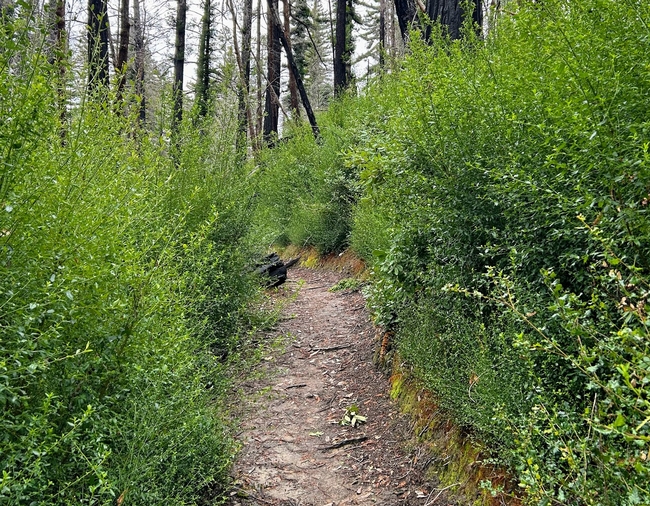Whether you've been hiking or driving through the CZU Fire burn footprint in the Santa Cruz Mountains, you might have noticed that the understory of the coast redwood (Sequoia sempervirens) forests look quite different from how they did before the fire. Besides the "fuzzy" appearance of coast redwood trees regrowing from their bases, stems, and branches, another notable change is the dense, shrubby understory. But have you ever wondered what that plant might be? In many cases, the plant in question is Ceanothus thyrsiflorus, also known as “blueblossom” or “California Lilac”. Blueblossom Ceanothus is a native woody plant that thrives in postfire and disturbed conditions. It's also a common landscape plant in California.

A native plant that thrives in the postfire and disturbed environments
You may not have noticed much Ceanothus in the understory prior to the fire, because it is relatively short-lived in forest settings, lasting decades rather than centuries. This plant undergoes "pulses" of recruitment, appearing and disappearing with fire events and the subsequent forest recovery. After a disturbance, blueblossom quickly takes root in various California Coast Range environments, including the redwood understory, just as it has after past fires. In the Santa Cruz Mountains, where many areas hadn't experienced a fire in over a century before the CZU Complex, mature blueblossom plants from the last recruitment pulse had died, making them scarce in the modern forest understory. But then, the heat from the fire triggered dormant seeds in the soil to germinate in large numbers, especially after they were dampened by rain. The post-fire conditions, with plenty of light and minimal competition, are ideal for the growth of woody shrubs, and as a result, the dense shrub layer has rapidly grown over your head in many areas.
Coast redwood, hardwood, and ceanothus sprouts make for a green forest understory over three years following the fire
Blueblossom lives up to its name, forming beautiful clusters of blue and white flowers that produce many seeds. Over time, as the coast redwood forest canopy continues to grow, the conditions that spurred this explosion of understory growth will fade, leading to the slow senescence and eventual death of the mature blueblossom. Left behind will be hundreds of thousands of tiny seeds, sitting in the soil seed bank, relatively undisturbed until the area experiences another fire in the future. But what about all the dead plant material that accumulates in the forest understory over time?
Management Implications
In recent discussions with local forest managers, blueblossom has been a recurring topic. Our understanding of how coast redwood forests react to high-severity fires like the CZU Complex is continuing to develop, and many questions remain about managing the postfire environment, including concerns about blueblossom. As a native species, blueblossom plays an important role in the postfire ecology of the Santa Cruz Mountains, but it may also exacerbate wildfire risks. As such, a balanced approach to management will be necessary. Historical ecological data indicate that blueblossom's presence in the understory is temporary. However, observations from the 2009 Lockheed Fire reveal that the death of blueblossom, as the forest canopy thickens, leads to significant accumulations of dead woody materials, forming dense "mats" as successive generations perish.

A tunnel of Ceanothus at Big Basin State Park in the Santa Cruz Mountains
With an increase in observed and projected fire frequency in the region, dense layers of live or dead blueblossom could potentially influence burn severity and fire behavior in the future. As a result, management of blueblossom will be necessary on some sites in the Santa Cruz Mountains, particularly around homes, legacy and old-growth trees, and other important natural and cultural resources. Unfortunately, blueblossom resprouts when cut early in its growth, so early management through mastication is unlikely to be effective. As the plant ages, however, it may become more manageable using mastication, livestock, prescribed fire, chemical, or a combination of these treatment types. While the best approach and timing for such interventions are yet to be fully known, ongoing demonstration projects and postfire treatments offer valuable insights, helping refine the most effective management strategies.
Monitoring Blueblossom and Studying Management Approaches
Through monitoring and experimentation, we can gradually gain a deeper understanding of postfire blueblossom ecology, as well as when, where, and how we should manage blueblossom to build resilience in our forest communities. I plan to work collaboratively with managers throughout the region to better understand optimal timing and methods for blueblossom management, its appropriateness and need, and to evaluate areas that may be the highest priority for treatment. If you are interested in monitoring or managing blueblossom on your property or already are, please reach out to me for a site visit or discussion.
